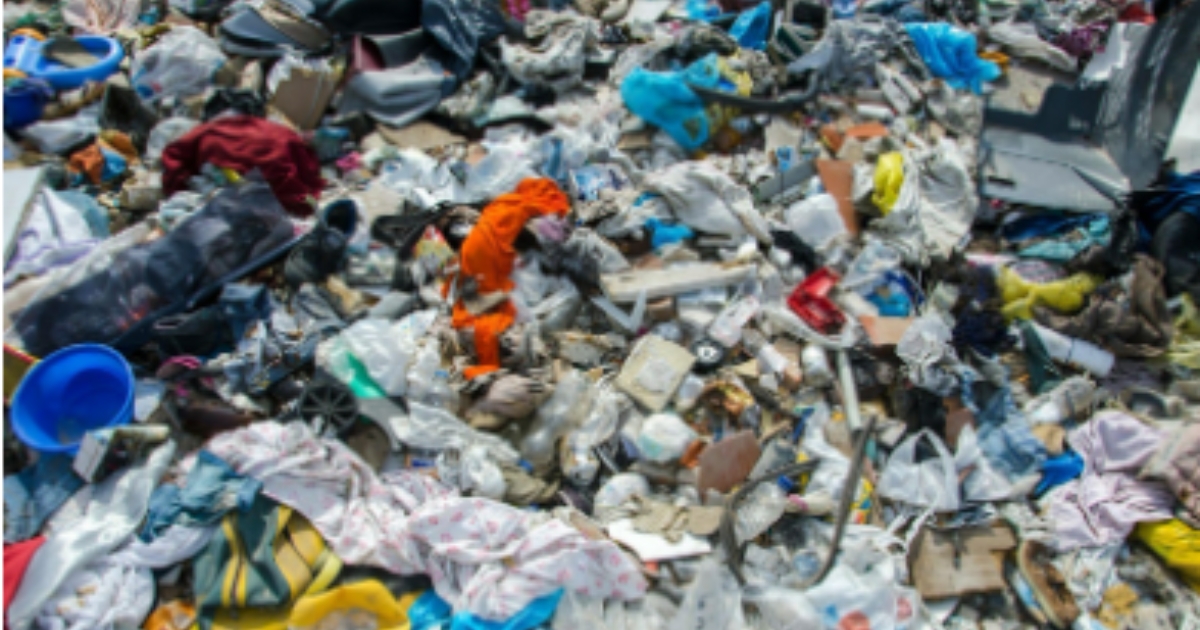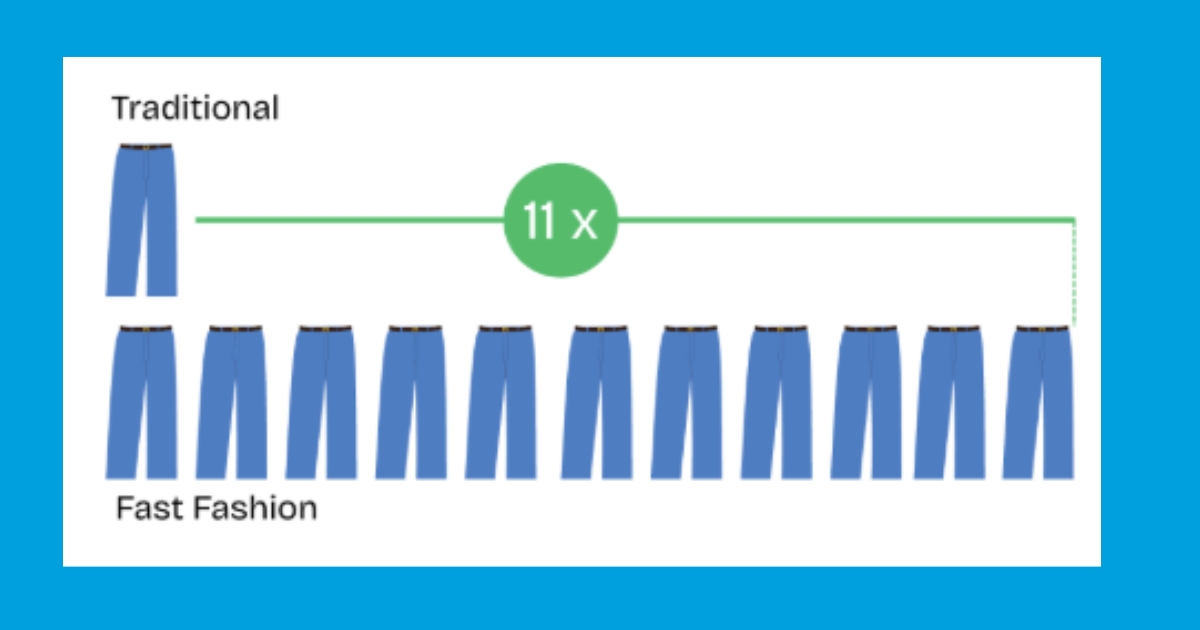
Fact Sheets And Publications
Fast Fashion and Sustainability
August 2025 | Written by: Megan Murtaugh
What is Fast Fashion?
The discussion surrounding “fast fashion” has grown in recent years as fashion trends have been connected to global warming. Fast fashion involves clothing trends spread through social media by popular influencers and celebrities. It promotes the idea of trends beginning and ending so quickly, that consumers buy articles of clothing to wear for a short period of time. Due to the high demand of these clothing items, they are poorly made and cheap to produce and sell. These pieces of clothing are produced in large quantities at low prices made to last for only a few wears. As the trends end, the clothing more often than not ends up in landfills. Approximately 85% of the clothing consumed by Americans, which equates to 3.8 billion pounds of clothing a year, gets sent to landfills as solid waste.

Fast Fashion and the Environment
According to Science Direct, it is estimated that fast fashion makes up 10% of global carbon emissions. The high demand of trendy clothes relies heavily on mass production, which is resource intensive. Often, clothing generation requires a large amount of water and other chemicals like dyes, not to mention the fabric sources. The manufacturing and transportation of millions of garments every year produces immense amounts of greenhouse gases, harming our atmosphere. If no changes are made, fast fashion emissions are expected to rise by 50% by 2030.

The detrimental effects of fast fashion come from the materials these clothes are made of. Approximately 90% of the clothing sold in the United States is made with cotton or polyester. Polyester is derived from oil, and cotton requires large amounts of water to produce. Clothing is easier to manufacture using these materials, but takes more energy to produce, and is harder to recycle. For example, articles of clothing made of nylon take about 30 to 40 years to decompose. Of these clothes made of synthetic fibers that end up in landfills, about 50% break down to release greenhouse gases. This need for mass production, high consumption, energy, and overall waste results in the carbon footprint of fast fashion being 11 times higher than that of traditional fashion.
Avoiding Fast Fashion
It is important that we, as a society, end the cycle of fast fashion to help minimize carbon emissions. Many people have begun to reject brands that make a business off fast fashion trends. Additionally, the public has begun looking into the ethics of clothing companies, to ultimately decide whether or not they want to patronize certain companies or not. Along with research, there are many ways individuals can end the fast fashion trend.
Sustainable Fashion
Instead of synthetic fibers for clothing, purchase clothing made from sustainable fibers. Synthetic fibers include polyester, nylon, acrylic, rayon, spandex, and microfiber. These fibers are derived from petroleum and are harmful to the environment. Checking labels when purchasing clothing to avoid synthetic fibers can be beneficial to the environment.
More sustainable fibers in garments will in turn last longer and the production of clothing using sustainable fibers emits less carbon. Using or purchasing fabrics like Lyocell, which is made from the cellulose of bamboo, combat fast fashion.
Second-Hand Trading
Second- hand trading can reduce the carbon footprint of fast fashion consumption by 90%. Since fast fashion encourages speedy turnover with articles of clothing, some of the clothes that end up at second- hand stores or thrift stores still have potential. Purchasing from these stores will not only help you obtain clothes you want at a lower price, but will help minimize waste, and potentially reignite an old trend!
Quality over Quantity
Fast fashion brands produce large quantities of clothing for low prices, which catches the eyes of consumers easily. It is important to prioritize quality over quantity. Many of the low-quality clothes derived from fast fashion do not last more than a few wears. Purchasing clothes with higher quality for a more expensive price is beneficial for the consumer and less harmful to the environment.
Mindfulness
Being intentional with every purchase is another way to reduce the negative impact of fast fashion. If you think an article of clothing is cute, but you don’t actually think you’ll wear it, don’t purchase it. If you want to purchase a garment just because it is cheap, you might not actually want to buy it. Being mindful with every piece of clothing you buy will prevent you from caving into the trend of fast fashion.
Alternatives to Disposing of Clothing
There are a variety of things to do with clothes when you are done with them. Regardless of whether the garment has outgrown your style, doesn’t fit anymore, or broke in some way, steps can be taken to reduce waste.
Selling
Selling clothes online or to a consignment store is a great way to reduce waste. It not only gives you a place to put these old clothes, but you obtain money in the process. Selling clothes gives them new life to new people.
Donate
Donating not only reduces clothing waste, but also helps people in need. Before donating clothes, ensure that they are in good condition. Clothes in good condition have a higher chance of being sold and a lower chance of going to waste. Additionally, before donating, research the store to which you wish to donate to see their environmental and social ethics.
Swapping Clothes
Swapping clothes with friends and family is a great way to refresh your closet and minimize waste. Just because you no longer want to wear a garment doesn’t mean it won’t catch someone else’s eye.
Unwearable Clothes
Some clothes are unsuitable for sale or donation because they are ripped, broken, or stained. Luckily, there are multiple ways to upcycle your old clothes.
Repairing your clothes is a great way to extend their lifespan. Learning to sew or patch holes is a great way to give clothes new life.
Taking old clothes and transforming them into new garments such as scarfs or bags is a fun and inventive way to repurpose old items.
Properly recycling clothes is crucial to avoiding harmful waste. Research local recycling programs near you to find the best ways to dispose of garments.
University of Delaware Clothing Coop
University of Delaware has a program offered through Student Diversity & Inclusion that provides access to free clothing for students. This includes professional and gender affirming clothing and accessories. Further information on how to make a Clothing Coop appointment can be found here.
Phoenix Used Clothing
Some organizations exist to aid in recycling clothing and place collection bins within communities. For example, in Delaware, Phoenix Used Clothing has 42 collection bins across the state. These bins accept unwanted and unusable items. Any articles of clothing they retrieve from the bins that are of good quality, get sent to a community partner of theirs, Phoenix Family Resources, to help those in need. Unwearable clothing is sent off to be reused, or properly recycled. Contributions to Phoenix Used Clothing both helps those in need, and positively impacts the environment. More information about the company can be found on their website.
About the Author
Megan Murtaugh, 2025 Extension Scholar, University of Delaware
Jennifer Volk (corresponding author), Associate Director, University of Delaware Cooperative Extension, Dover, DE (jennvolk@udel.edu)
About this Publication
Original Publication Date: August 2025
References
CANVA: Visual Suite for Everyone, www.canva.com/
Author links open overlay panelZhikun Li a, et al. “The Carbon Footprint of Fast Fashion Consumption and Mitigation Strategies-A Case Study of Jeans.” Science of The Total Environment, Elsevier, 7 Mar. 2024, www.sciencedirect.com/science/article/abs/pii/S0048969724016498
Bick, Rachel, et al. “The Global Environmental Injustice of Fast Fashion - Environmental Health.” SpringerLink, BioMed Central, 27 Dec. 2018, link.springer.com/article/10.1186/s12940-018-0433-7
Godin, Seth. The Carbon Almanac: It’s Not Too Late. Portfolio Penguin, 2022.
Rukhaya, Shalini, et al. “Sustainable Approach to Counter the Environmental Impact of Fast Fashion .” The Pharma Innovation, 2021
Wiseman, Celia. “6 Sustainable Ways to Get Rid of Old Clothes and Shoes: Eco-Stylist.” Eco, 5 May 2025, www.eco-stylist.com/6-sustainable-ways-to-get-rid-of-old-clothes-and-shoes/
“Clothing: Blue Hen Essentials: Student Support: University of Delaware.” Blue Hen Essentials | Student Support | University of Delaware, www.udel.edu/students/support/blue-hen-essentials/clothing/
Community Partners, https://phoenixusedclothing.online/community-partners
UD Cooperative Extension
This institution is an equal opportunity provider.
In accordance with Federal law and U.S. Department of Agriculture policy, Cooperative Extension is prohibited from discriminating on the basis of race, color, national origin, sex, age, or disability.
